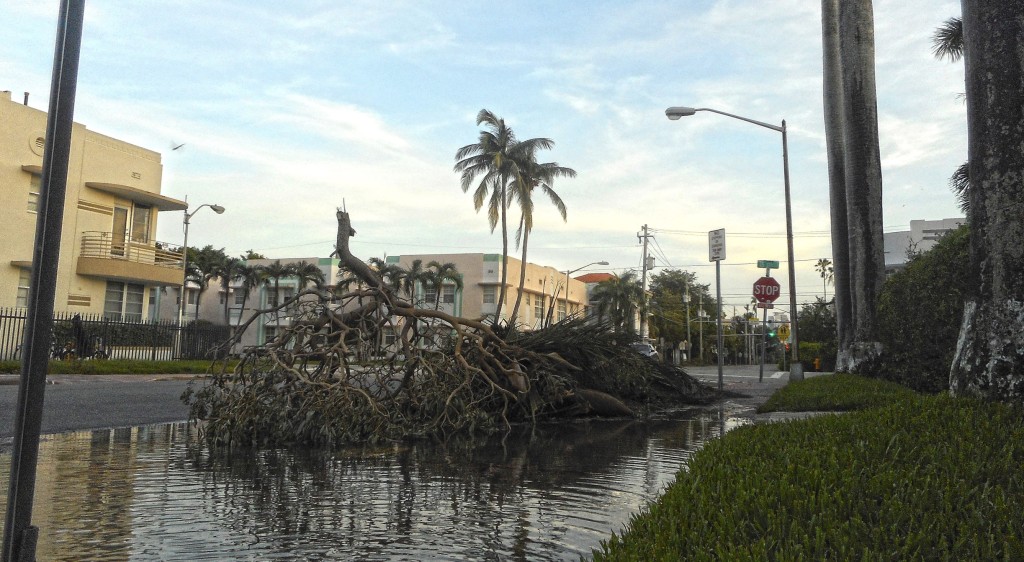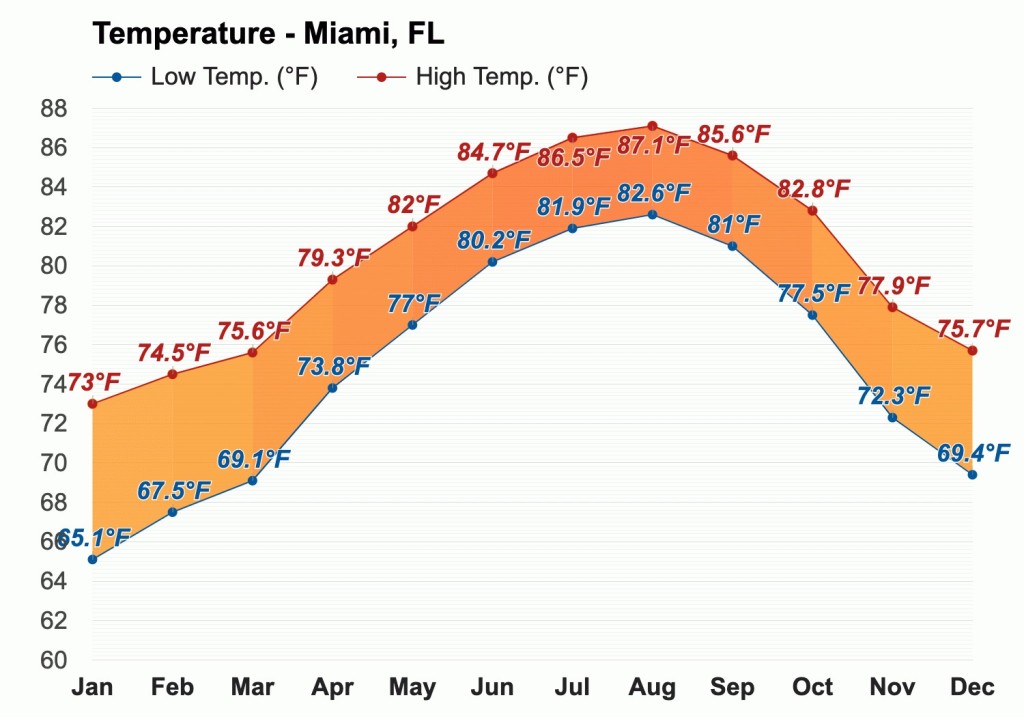
Many people dream of taking a vacation in Miami, Florida, and with good reason. The beaches, fauna, and flora are exceptional and tropical while the lifestyle of Miami is casual. There are also plenty of activities in Miami for children as well as the jet-setting party crowd (particularly during times like spring break).
The city is packed with attractions, but it is not the best vacation location all year round. In our guide, we will talk about the worst time to visit Miami.
Also, check out the worst time to visit New York.
Worst Time to Visit Miami
Hurricane season (June 1st to November 30th) is the worst time to visit Miami with the peak months being August, September, and October. The probability of hurricanes and tropical storms peaks in the tropics from May to November, while they may occur at any time. Miami was slammed hard by Hurricane Irma in September 2017, resulting in severe flooding and devastation.

Several reports highlighted that during 2022’s hurricane season, a total of 14 named storms were recorded, out of which eight attained hurricane status. 2 further escalated to major hurricanes, characterized by winds reaching or exceeding 111 mph.
The Miami region gets hit by a hurricane once every 1.97 years, according to statistics from the National Hurricane Center. On average, Miami is battered by a hurricane every five years. On average, a major storm occurs once every 12 years. An average of 110 mph winds are blowing. As they traverse the Atlantic and move north, hurricanes can endure anywhere from a few hours to many weeks before dissipating.
Here is a summary of the few hurricanes that have hit Miami in recent years:
| Year | Hurricane | Category | Impact on Miami |
| 2022 | Hurricane Nicole Hurricane Ian | Category 4 | Strong winds and heavy rainfall with a $50 billion damage toll |
| 2020 | Hurricane Eta | Category 4 | Heavy rainfall and flooding in parts of South Florida |
| 2019 | Hurricane Dorian | Category 5 | Avoided a direct hit but brought concern and indirect effects |
| 2017 | Hurricane Irma | Category 4 | Strong winds, heavy rain, significant damage, power outages |
| 2016 | Hurricane Matthew | Category 4 | Outer bands caused heavy rainfall and gusty winds |
| 2016 | Hurricane Hermine | Category 1 | Brought heavy rain and gusty winds to some parts of Florida |
Things to Know Before Visiting Miami During Hurricane Season
Storms are notoriously hard to forecast and are known to abruptly shift course. These resources and precautions might be helpful if you are visiting Miami during a significant storm:

- Keep an eye on airline announcements, hotel cancellations, and information from National Hurricane Center about storms so you know what to expect on your trip.
- Consider purchasing a travel insurance policy. Pay close attention to things like compensation for missed connections, flight delays, and cancellations.
- To see whether your home/hotel is at risk of flooding, look up your address on the Miami Dade Storm Surge Planning Site.
- Keep an eye on the Miami Dade Evacuation Orders website for updates.
- Make sure you always have some spare cash on hand. During a storm, it is possible that ATMs and credit card processing are interrupted.
- Always have your phone with you, and make sure it is charged. You should always have a way to get in touch with loved ones and the authorities in case of an emergency.
- Take caution in getting back to your hotel once the storm has gone. There might be risks in the area, such as fallen power lines or water. Take pictures of the damage and report it to your insurance carrier as soon as you can.
Why Hurricane Season is the Worst Time to Visit Miami?
In a nutshell, hurricane season is the worst time to visit Miami because you will only be confined to your hotel. There are going to be no outdoor activities as authorities restrict human movement. You will not be able to enjoy your trip. Even if there is pleasant weather at one moment, sudden changes are expected at another time as well.
Storm surges and strong winds are the most hazardous aspects of a hurricane. However, the effects are typically amplified by heavy rain, floods, and rip currents. The rapid return to hurricane conditions after the storm has passed is a leading source of injuries sustained by those who go outside to examine the damage after the storm’s passage.

Moreover, people are at risk from flying debris. At the greatest levels, a person may be thrown into the air, automobiles can be flipped over, and flying debris can cause serious injury or death. Young children and pets in particular may find the noise to be rather disturbing.
High heat and humidity are to be expected since hurricane season is often the warmest time of year in Miami. It is possible that hurricane-related flight delays can force you to extend your stay in Miami. The most crucial piece of advice is this: take storms seriously.
Hurricanes are very unpredictable; therefore, forecasts for their courses often shift from day to day. Keep yourself well-informed and ready. Avoid any low-lying or exposed sites that can be damaged by the storm. The same goes for any building projects or low-lying regions like beaches. If you find yourself in the path of a storm, seek refuge in a safe structure and remain inside until the weather clears.
Also, check out the Best Ramen Spots in Miami.
Other Worst Times to Visit Miami
Hurricane isn’t the only aspect to keep in consideration when visiting Miami. There are also a few other seasons when we don’t recommend visiting Miami.
Summer Season in Miami
Miami summers are brutal due to the high temperatures, high humidity, and high intensity of the sun. The Miami Heat is real and should not be taken lightly. Because of Miami’s topography, the state’s average temperature is only in the low to mid-nineties, even though it seems much cooler.

However, the situation is more severe than it seems. The high humidity in Florida makes even the mild 90s seem like a furnace. When you step out of the cool comfort of an air-conditioned building, you will quickly get soaked in perspiration.
Check out the following temperature chart for Miami!
Miami Monthly Temperatures | ||
| Month | Average High Temperature (°F) | Average Low Temperature (°F) |
| January | 75°F | 59°F |
| February | 76°F | 60°F |
| March | 78°F | 63°F |
| April | 81°F | 67°F |
| May | 84°F | 71°F |
| June | 87°F | 75°F |
| July | 88°F | 76°F |
| August | 89°F | 76°F |
| September | 88°F | 75°F |
| October | 85°F | 71°F |
| November | 80°F | 65°F |
| December | 76°F | 61°F |
Daily strong thunderstorms are the sole reprieve, and they can decrease the temperature by twenty degrees in a matter of minutes. The humidity after a rainstorm is so high that it seems like it is 100 percent, so even those have their drawbacks. Storms may also reduce wind speed and decrease the cooling benefits of a sea breeze.
Make sure your accommodation has air conditioning and plan inside activities during the afternoons if you can during the summer months. Make sure you use a generous amount of water-resistant sunscreen. You could hope that the water would provide relief from the heat, but if the weather is hot for a long time, the ocean will also heat up.
Therefore, summer is one of the worst seasons to visit Miami, especially the months of August and September.
Related Read:
Most Crowded Months to Visit Miami
Miami is at its busiest and most frequented during the winter months (November–March) because of constant sunlight, low humidity, little precipitation, and comfortable mid-70 F temps. That means the beach is in pristine shape. Beautiful weather attracts many people. From November through February, Miami’s population booms as snowbirds flock there for the winter sun. Tourists who want to experience the first Thanksgiving or Christmas with palm palms as decorations.

If you want to visit Miami and escape the crowds, planning your trip during the winter is not a good idea. The large number of people here is more than a nuisance. They have a direct effect on the expenses of renting a vehicle, Air tickets, and staying in a hotel.
Since there is a lot to see and do in Miami during the winter, you should expect to spend more to go there then. More money may need to be spent on travel and lodging, and certain events at restaurants and bars may require prepayment, a fixed menu, or a reservation charge.
Editor’s Pick: Worst Time to Visit Yellowstone National Park – Avoid These Months
When is the Worst Time to Visit Miami: According to Other Tourists?
Hopdes board member, Zalah Khan recently visited the US. She told me, “Summer is very unpredictable in Miami. Clouds would swoop in, rain would pour for a while, and then the storm would go on. A handful of the days were overcast for me. I will not recommend anyone to visit Miami in August and September because of the noise it makes during storms”.
Hopdes Senior editor Bilal Ahmed informed me,” I made a big mistake by visiting Miami during hurricane season. There were cancellations of trips due to the threat of high waves. We were unable to go on any outside excursions throughout our holiday due to the persistent rains.”
Recommended Read: Worst Time to Visit Las Vegas – Month-by-Month Guide Included
Month-by-Month Analysis: Worst Months to Visit Miami
Following monthly analysis is going to help avoid the worst time to visit Miami.

January
- Average temperature: High of 75°F (24°C), low of 59°F (15°C)
- Weather: Mostly sunny with occasional cool fronts, but still enjoyable for outdoor activities.
- Activities: Enjoying the beach, swimming, snorkeling, exploring the Everglades, and visiting museums and art galleries.
- Special events: Art Deco Weekend, South Beach Wine and Food Festival.
- Crowd level: Moderate to high, especially during special events.
February
- Average temperature: High of 76°F (24°C), low of 60°F (16°C)
- Weather: Similar to January with pleasant temperatures and plenty of sunshine.
- Activities: Beach activities, water sports, boat tours, and visiting attractions like the Vizcaya Museum and Gardens.
- Special events: Miami International Boat Show, Coconut Grove Arts Festival.
- Crowd level: Moderate, with an increase during special events.
March (Most Crowded Time to Visit Miami)
- Average temperature: High of 78°F (26°C), low of 63°F (17°C)
- Weather: Warmer temperatures with occasional breezes. Ideal for outdoor activities.
- Activities: Beach time, jet skiing, paddle boarding, visiting the Miami Seaquarium, and exploring Jungle Island.
- Special events: Calle Ocho Festival, Miami Open (tennis tournament).
- Crowd level: High, especially during the Calle Ocho Festival and Miami Open.
April
- Average temperature: High of 81°F (27°C), low of 67°F (19°C)
- Weather: Warm and pleasant, perfect for beach activities and outdoor exploration.
- Activities: Beach picnics, sightseeing cruises, exploring the Miami Design District, and enjoying outdoor dining.
- Special events: Miami Beach Gay Pride, Miami Riverdale Festival.
- Crowd level: Moderate to high, especially during special events.
May
- Average temperature: High of 84°F (29°C), low of 71°F (22°C)
- Weather: Increasing heat and humidity, occasional showers, but still great for outdoor fun.
- Activities: Beach days, water sports, visiting the Miami Children’s Museum, exploring Little Havana.
- Special events: Miami Museum Month, Miami Fashion Week.
- Crowd level: Moderate, except during special events.
June (Overall Worst Time to Visit Miami)
- Average temperature: High of 87°F (31°C), low of 75°F (24°C)
- Weather: Hot and humid, with occasional afternoon thunderstorms. Beaches and indoor activities are popular.
- Activities: Beach relaxation, indoor attractions like the Frost Museum of Science, shopping at malls and outlets.
- Special events: Miami Film Month, Redland International Orchid Show.
- Crowd level: Moderate to high, especially during Miami Film Month.
July
- Average temperature: High of 88°F (31°C), low of 76°F (24°C)
- Weather: Hot and humid, with occasional thunderstorms. Beaches, water parks, and air-conditioned venues are preferred.
- Activities: Beach days, water sports, visiting the Miami Zoo, exploring the Wynwood Walls.
- Special events: Miami Spa Month, International Mango Festival.
- Crowd level: Moderate, except during special events.
August (Hottest Month to Visit Miami)
- Average temperature: High of 89°F (32°C), low of 76°F (24°C)
- Weather: Hot and humid, with occasional afternoon showers. Indoor activities and water-based adventures are popular.
- Activities: Beach time, water sports, visiting the Pérez Art Museum Miami, enjoying indoor entertainment venues.
- Special events: Miami Spice (culinary event), Miami International Auto Show.
- Crowd level: Moderate, except during special events.
September
- Average temperature: High of 88°F (31°C), low of 75°F (24°C)
- Weather: Warm and humid, with occasional rain showers. Indoor attractions and cultural activities are favored.
- Activities: Exploring museums, visiting the Venetian Pool, enjoying local cuisine, and indoor shopping.
- Special events: Miami Spice, Miami Fashion Week.
- Crowd level: Moderate to low.
October
- Average temperature: High of 85°F (29°C), low of 71°F (22°C)
- Weather: Cooling down with less humidity, and occasional showers. Ideal for outdoor activities and exploring.
- Activities: Beach days, kayaking, visiting the Miami Museum of Science, and strolling through the Miami Beach Botanical Garden.
- Special events: Miami Carnival, Halloween events.
- Crowd level: Moderate, except during special events.
November
- Average temperature: High of 80°F (27°C), low of 65°F (18°C)
- Weather: Pleasant temperatures, lower humidity, and less rain. Great for outdoor adventures.
- Activities: Beach time, snorkeling, visiting the Fairchild Tropical Botanic Garden, and exploring the Art Deco Historic District.
- Special events: Miami Book Fair, South Miami Art Festival.
- Crowd level: Moderate.
December
- Average temperature: High of 76°F (24°C), low of 61°F (16°C)
- Weather: Mild temperatures with occasional cool fronts. Ideal for outdoor activities and festive celebrations.
- Activities: Beach days, boat tours, holiday shopping, exploring the Vizcaya Museum and Gardens.
- Special events: Art Basel Miami Beach, Winterfest Boat Parade.
- Crowd level: Moderate to high, especially during Art Basel and Winterfest Boat Parade.
Also, check out our other “When to Visit” Guides!
Conclusion
Visiting Miami for a vacation is a great idea, but being mindful of the worst times to visit Miami is even better. This would help you plan out the right kind of vacation and enjoy it to your best. You’ll be able to avoid the wrong times and visit the city at the best possible times. We hope that our in-depth guide helps you out.
Worst Time to Visit Miami - FAQs
The busiest tourist seasons in Miami are typically during the winter months, particularly from December to February. This period attracts visitors seeking to escape colder climates. The influx of tourists can impact availability and drive prices higher for accommodations and attractions. Additionally, the spring break season in March and early April can also be busy and impact crowd levels.
The worst time to visit Miami would typically be during the peak of hurricane season, which runs from June 1 to November 30. August, September, and October are the months with the highest risk of hurricanes and tropical storms.
Miami experiences hot and humid weather throughout the summer months, typically from June to September. July and August tend to have the highest temperatures and humidity levels. If you prefer milder weather, you may want to avoid visiting during these months.




